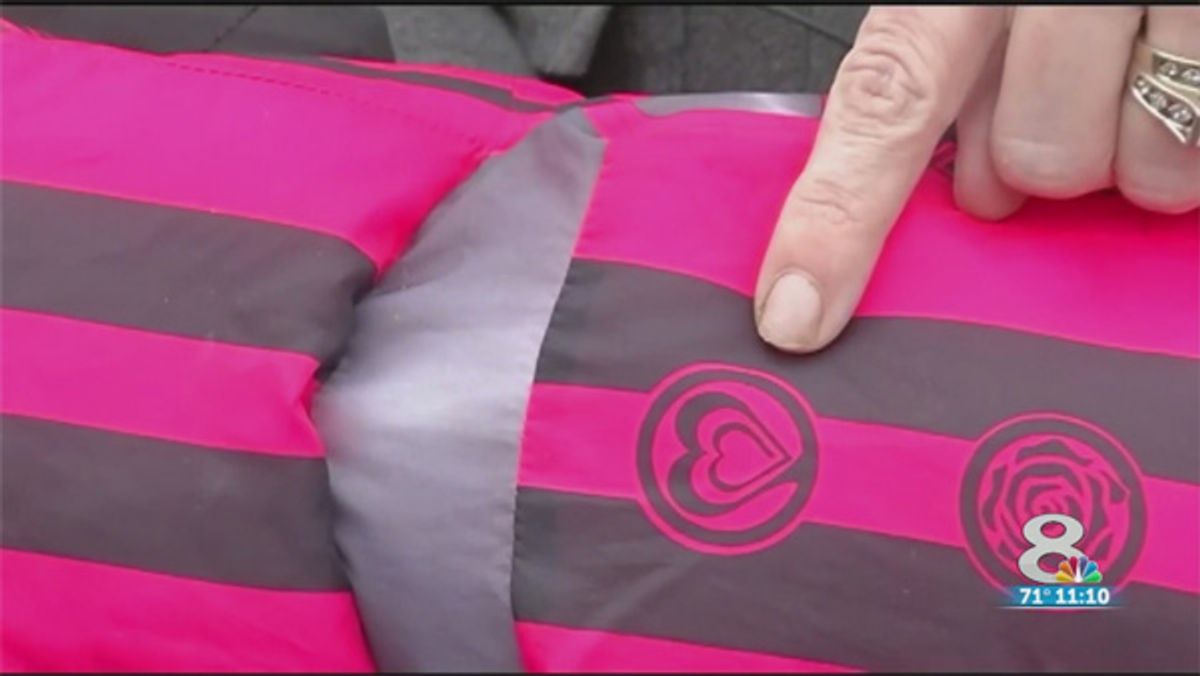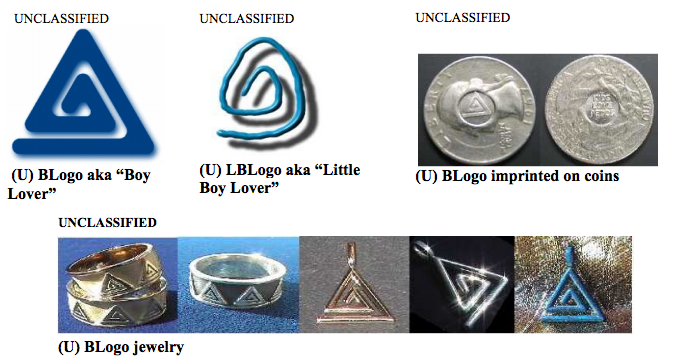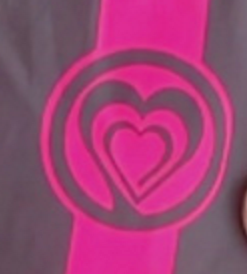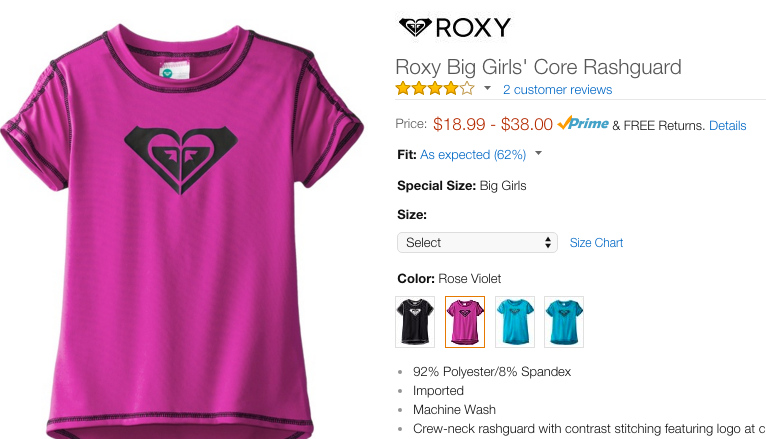Police in Pasco County were surprised to discover a symbol similar to secretive coding used by pedophiles on a Monster Jam souvenir toy.
The presence of imagery similar to the symbol poses a risk to children.
How the symbol came to appear on the Monster Jam toy and the extent of its actual use by pedophiles.
On 9 March 2016, WFLA released a report claiming that a secretive symbol widely used by pedophiles was discovered on souvenir plush monster truck toys marketed to girls at a Florida Monster Jam event.
The article was suspiciously light on details and high on appeals to fear, and made up mainly of shocked parental reactions, comments from local police, a statement from the palpably confused event organizer, and a video assertion that the toy amounted to a "big neon sign that a pedophile would give a child to another sicko." Its most substantive portion maintained:
Here's what the heart means. When a pedophile sees children with the heart symbol, it's a code. It means this child is ready to be traded for sex.
Pasco Detective Anthony Bassone has been with the agency for more than 16 years. He has one tough job every day. And, what he encounters, he can't forget. He has to see the worst of the worst. He picks out pedophiles online and busts them, along with two other detectives in the cyber crimes unit at the Pasco County Sheriff's Office.
These investigators have to deal with the most horrendous, gut-wrenching, heartbreaking material. Sadly, they see children tortured and raped on a daily basis.
These crime-fighters make it through with their motivation to protect children and keep them safe. What drives these detectives to do their jobs and face another day, they told us, is to put the bad guys away.
The rumor bore many hallmarks of urban legends rooted in fear of lurking pedophiles (particularly popular on social media), and its accompanying news coverage did little to assuage the inevitable fear parents would feel hearing such a report. Missing from the coverage was information on how WFLA came to learn of the toy, who made the connection about pedophile codes, of even any information about how or why such a code might be known or used (except as unspecified signaling between "sickos").
We contacted Pasco County Sheriff's Office Detective Anthony Bassone, of the jurisdiction's cyber crimes unit. Det. Bassone was familiar with the story, and provided a wealth of useful information.
According to Bassone, the heart symbol in question indeed bore some resemblance to imagery disseminated by the Federal Bureau of Investigation's Cyber Division Innocent Images National Initiative to law enforcement agencies on 31 January 2007. (We were unable to locate the document anywhere other than Wikileaks, and Bassone told us that slides from the FBI's release later appeared on an episode of Law and Order: Special Victims Unit.) The communication tipped law enforcement in 2007 to the existence of the symbols and common applications among pedophiles:
Pedophiles, to include those who sexually abuse children as well as those who produce, distribute, and trade child pornography, are using various types of identification logos or symbols to recognize one another and distinguish their sexual preferences. To specifically indicate the pedophile's gender preference, members of pedophilic organizations encourage the use of descriptions such as "boylove", "girllove", and "childlove."
These symbols have been etched into rings and formed into pendants, and have also been found imprinted on coins.
The application of such symbols was again described in a separate portion of the release:
Pedophilia symbols on jewelry, coins, Web sites and other effects are indicative of advertisement methods used by child sexual predators to promote their cause. Pedophile activists advocate for the social acceptance of sexual relationships between adults and children. These organizations seek to decriminalize sexual relationships between adults and children and to legalize child pornography based on their belief that children have the ability to consent to sexual acts. (U//LES) Identical or similar jewelry and symbols as described in this intelligence bulletin should raise suspicion of possible pedophilia activity when found during searches.
The document described the symbols as used by pedophiles to denote their own preferences, not ones reserved to mark children as potential or available victims. A later portion read:
The GirlLover logo (GLogo) depicted below is a small heart surrounded by a larger heart, which symbolizes a relationship between an adult male or female and minor girl.
The release was available in full online [PDF], complete with photographs of the symbols:
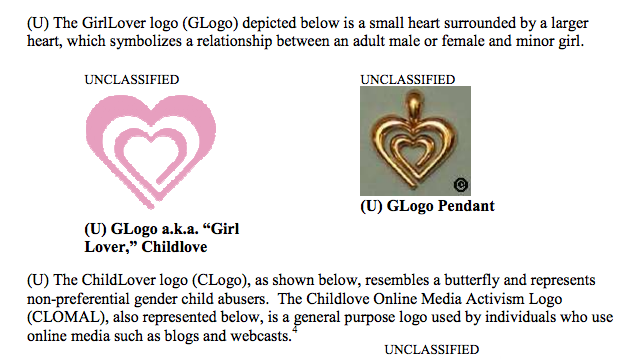
The symbol on the plush monster truck was similar:
It was also similar to the logo of popular surf brand Roxy, which features a large line of clothing for young children and tweens:
Bassone told us that the use of interlocking hearts in and of itself was unlikely to put any child in danger, adding that the department was attempting to talk to the designer to learn more about the choice of symbol.
However, he explained that the appearance of the symbol on children's items was off-putting from the perspective of a cyber crimes detective, as they may be widely recognized by pedophiles. Bassone noted that while the symbol wasn't necessarily dangerous or presenting a risk of child exploitation, it was possible in-the-know pedophiles would find the use of the symbol on children's clothing or toys to be stimulating or amusing.
Feld Inc. responded to our inquiry, confirming that the item was since pulled from their inventory. Spokesman Stephen Payne said in a statement that the company was unaware the heart symbol bore any relation to pedophile shibboleths. The tenor of the statement suggested that the maker of the toy was genuinely horrified to learn of the rumors and took immediate action upon hearing the rumors:
On Tuesday, March 8th, when the issue with the Monster Jam toy was brought to the company's attention by a customer who purchased it at a recent Monster Jam event, we immediately pulled this item from inventory and will no longer sell it. In addition, any customers who have purchased this truck can contact our Customer Service Department for an exchange or refund.
The company was not aware of the disturbing message contained in the truck's design, nor did we intend to use any design that had a secret or double meaning. We are currently reviewing our merchandise to ensure that it's appropriate for our customers.
Feld Entertainment is committed to providing a safe and family-friendly environment at all our shows and through our consumer products. We take this very seriously and are taking steps to ensure that an incident like this never happens again.
It's true that a toy sold at Monster Jam bore a symbol similar to one used by pedophiles, and that toy has since been pulled from the event's merchandise inventory. However, that symbol was not exclusive to pedophiles and did not "mark" children for abuse. Feld Inc. asserted that they were unaware of the connection, but immediately acted to remove the toys from circulation. After this post was published, a number of readers pointed out a very similar and widely distributed Unilever-brand ice cream logo:
Urban legends about use of symbols in crime are rife, as they enable people to feel one step ahead of crafty criminals. Perennially popular warnings about robbery and dog theft were very similar to the pedophile code rumor. But it's worth keeping in mind that studies have consistently demonstrated strangers pose a far smaller risk than individuals close to a child, such as a relative or a friend of the family. Only 10 percent [PDF] of assaults were committed by a stranger, a number reiterated by the United States Department of Justice. The bulk [PDF] of abuse is committed by family members, family friends, or other trusted adults without the use of coded toys.
